Photonics adds spice to an avatar-filled digital cosmos.
Avatar-inhabited online worlds such as Second Life (SL) could be the next new wave of the Internet. Science-related organizations and companies, along with a number of academic institutions, already have begun establishing residency in these digital environments. Some photonics technologies are now represented in Second Life, mainly in virtual educational settings.
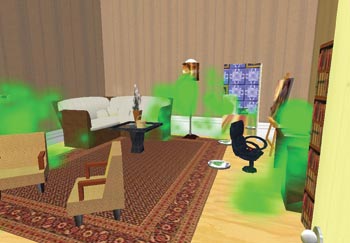
Tony Crider’s students built a virtual carbon footprint house as part of their final project in Introduction to Astronomy. The visible green gas on the appliances in this room represents the greenhouse gases emitted by their use. Photo courtesy of Tony Crider (Chaac Amarula in SL).
Openly accessible via the Internet, Second Life, one of the more well-known 3-D virtual worlds, is continually being created by Residents, or avatars – incarnations in human form, according to the dictionary – of people in the real world. With the ability to fly or teleport, avatars can initiate chemical reactions, walk through the structures of cells, fly through a hurricane on a P-3 Orion Hurricane Hunter, or share 3-D models and designs. Avatars attend “inworld” events, including films, s and speaker presentations. They virtually shop for luxury items, buy land and buildings, create objects with inworld building tools, give lectures, attend classes, listen to and create music, seek entertainment and pursue other interests.
Technically a video game, this real-time streaming “world” was launched by Linden Lab of San Francisco in June 2003.
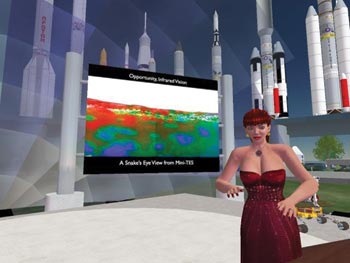
Shown is avatar Patio Plasma talking about NASA’s Mars Exploration Rovers at the International Spaceflight Museum in the virtual world of Second Life. The image behind her was captured by the Mini-TES, a thermal emission spectrometer onboard one of the Rovers. The device allowed scientists to locate hematite (shown in red) on the planet. Paul Doherty, creator of the avatar, is a solid-state physicist and senior staff scientist at the brick-and-mortar Exploratorium museum. Photo courtesy of Troy McConaghy (Troy McLuhan in SL).
The SciLands
In one corner of the Second Life world, the science “islands” of the SciLands are currently “owned” or occupied by several organizations, including NASA and the National Oceanic and Atmospheric Administration (NOAA), both in Washington; the National Institutes of Health in Bethesda, Md.; National Physical Laboratory in Teddington, UK; Elon University in North Carolina; and the Exploratorium: the museum of science, art and human perception in San Francisco. “Islands” devoted to the areas of nanotechnology and genetics are found here as well.
Devoted to science and technology, the SciLands mini-continent was formed in 2006 and initially was based on the space industry and SL’s International Spaceflight Museum. It is designed to provide shared resources, events and networking for organizations interested in science education, innovation, knowledge transfer and research, as well as access to resident experts in the field.
On its virtual island, the Exploratorium – a hands-on museum in real life – features a demonstration using particles to model photon motion in straight lines from an extended source to show the origin of the umbra in a solar eclipse.
In August 2008, the Exploratorium mixed real and virtual-world experiences, as it has in the past, when its team presented a live Webcast of a total solar eclipse from the Xinjiang province in northwestern China. Avatars representing their humans gathered for an eclipse Webcast viewing party in SL.
Anthony Crider, co-founder of the SciLands and associate professor of physics at Elon University, said that many people seemed to enjoy the communal aspects of SL, noting that those who are housebound for one reason or another might prefer to watch the eclipse or some other event in the virtual company of others – represented by their avatars, as opposed to watching it on television, for example.
A feel for Mars
SL simulations can provide people with a sense of time and place, he said, such as what it feels like to be on Mars or the moon, and can get a feel for the size of the rocks, hills and mountains.
The science islands have grown explosively over the past two years, Crider said, and as the SL environment evolves, its next reincarnation likely will become easier to use. He believes that it will become second nature to students and others, much the same as e-mail, text-messaging and Web site searching are now.
He said that the re-creation of benchtop laboratory equipment and instruments on SL, along with interactive demonstrations of how to use them, could be a practical use of the 3-D world for science companies promoting these items. He said he has done a re-creation of an instrument that would beep or buzz when an avatar used it in the wrong way.
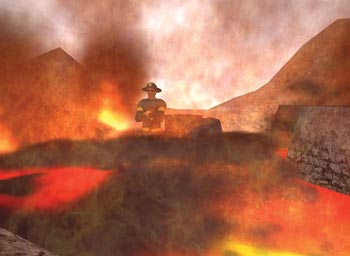
An avatar stands inside NOAA’s virtual volcano in the SciLands. Photo courtesy of Eric Hackathorn (Hackshaven Harford in SL).
Eric Hackathorn, an information technology professional at NOAA, designed the organization’s presence in the SciLands. His work enables virtual visitors to witness a tsunami, to assist in the cleanup of an oil spill and to take a ride on a weather balloon to learn about instrumentation used to collect atmospheric data. He said he noticed a higher level of engagement and interactivity inworld than on a 2-D Web site. People can control what is going on, he noted.
In the future, Hackathorn said, we might see a blending of the material and of the virtual worlds, such as of Google Earth-type images and avatars who might meet in real-world scenes for work and leisure activities. He is interested in a collaborative data visualization that could be realized through online social networking. As an example, he said, in a sense, the input of many people possibly could lead to an accurate weather forecast. A large audience bearing an optimal collective intelligence someday might predict the weather.
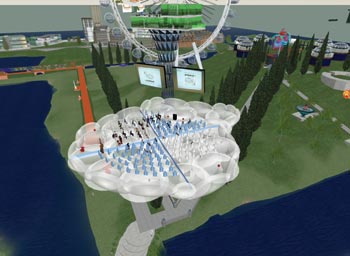
An inworld auditorium, the Skyditorium was constructed by Troy McLuhan (Troy McConaghy in real life). The structure is situated at the four-corner junction of four Second Life simulated areas: the SciLands orientation island, UK Future Focus, the Exploratorium and Nanotechnology. Each area can hold about 70 avatars. By combining the corners of the four areas, the Skyditorium theoretically can handle 240 to 280 avatars. Avatars are shown attending an inworld session of the Metaverse U Conference at Stanford University in February 2008. Photo courtesy of Spike MacPhee (Paradox Olbers in SL).
Getting an inworld education
Simulated ivory towers, hallowed halls, chalkboard classrooms and spacious auditoriums of brick-and-mortar colleges and university campuses are finding their way into the storybook world of Second Life. Professors and students, as avatars, are beginning to teach, learn and confer there as they do in real life, except that they can enjoy the benefits of social networking in real time while at their remote sites, which could be in any part of the material world. Harvard University in Cambridge, Mass., Texas State University-San Marcos and Stanford University in California are among the institutions that have set up virtual campuses.
David J. Webb, whose field of research is photonics, began exploring the potential of virtual worlds for educational purposes just a few months ago. A professor in the electronic engineering department at Aston University in Birmingham, UK, he will be running student projects related to virtual robotics next year.
He said virtual worlds offer great potential in providing a sense of community and participation for distance learning. He believes that they are excellent environments for practicing the creative disciplines, such as product design and architecture, especially because there is a large resident population to provide feedback on what has been designed and an economy in which to operate. From the research perspective, he noted, if more people become familiar with operating in virtual worlds, there may be advantages to be gained in “face to face” networking and in virtual collaboration on documents.
Webb also pointed to experimental online technology, such as Project Wonderland: A Toolkit for Building 3-D Virtual Worlds, which is under development by Sun Microsystems Laboratories, the research and development branch of Sun Microsystems in Menlo Park, Calif., and by the open-source community. This tool would allow anyone to host his/her own world and enable organizations to remain independent of other online world companies.
Interoperability among online worlds?
There are many online worlds besides SL on the Internet, among them Active Worlds, Muse, Cybertown, Worlds.com., Moove and Google’s newly launched Lively.
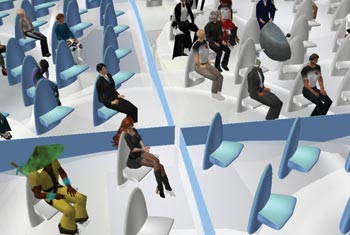
Avatars attending a conference in the Skyditorium display various modes of dress, including a traditional sun hat (lower left, in green) and satellite communications dish headwear, upper right, in gray). Photo courtesy of Spike MacPhee (Paradox Olbers in SL).
Recently, Linden Lab, the creator of Second Life, and IBM, based in Armonk, N.Y., have demonstrated interoperability among these worlds by teleporting avatars between the Second Life Preview Grid and the OpenSimulator virtual world server. Still in early development, this open standard of interoperability would allow avatars to move from one world to another, just as Internet users now can move from one Web site to another. The protocol could take virtual worlds to a greater functional level, enabling individuals and organizations to move among the worlds to more effectively pursue business, educational and other activities.
A First Visit
As Tari Triellis, I, the author, set out to explore Second Life for the first time. Selecting a name for my avatar took time, and selecting apparel for her was another task, although not an unpleasant one. I could see how it would be tempting to shop inworld for glamorous clothing for my avatar.
In my inworld wanderings, I visited a bookstore where, if you clicked on the virtual books, you would be connected to a description of the book on a Web site. I wandered into a rental agency and later received a real-world e-mail asking if I wanted to rent inworld real estate.
I also watched a “machinima” – a film made entirely in a virtual world – of a meteor impact simulation on the Martian surface. I floated across empty seas and through deserted museums and lush, mystical forests, occasionally meeting another avatar to whom I could have text-messaged or spoken but didn’t – nor did they to me. I look forward to attending an inworld event sometime soon, however. I hear that avatars gather to attend National Public Radio’s “Science Friday” program every week.
Interested in visiting Second Life?
Visitors can download the program at www.secondlife.com, where they also will learn the computer requirements for the game and find information on membership plans and their costs and benefits. A free-access basic plan is available for those who just want to get their cyberfeet wet. Information is presented on purchasing virtual land and on the value of the inworld currency, the Linden dollar, which represents real-world hard cash.
A presence for your organization?
A platform called Second Life Preview Grid is specifically designed for organizations that are interested in establishing an inworld presence. Providing various channels of communication, including images, audio, video, text and voice, the program enables companies to engage in virtual meetings, job interviews, training sessions, meetings and project collaboration, which could reduce the expenses of real-life travel and downtime. Organizations can establish private or public 3-D meeting spaces where participants can communicate using voice and text in real time, according to the Second Life Web site.
Virtual Tools for Microscopy
More than 300 researchers worldwide have employed the virtual environment for dynamic atomic force microscopy (VEDA) since it became available online in 2007. The “cyberinfrastructure enabled” suite of simulation tools is under development on the nanoHub portal (www.nanohub.org), which is operated by the Network for Computational Nanotechnology at Purdue University in West Lafayette, Ind. The nanoHub is a Web-based resource for research, education and collaboration in nanotechnology.
The simulation tools enable scientists and researchers to interpret raw data collected with dynamic atomic force microscopes (dAFMs), which use a tiny vibrating probe to yield information about materials and surfaces on the nanometer scale. Researchers use the instruments to determine a material’s magnetic, electrical and physical properties, the contours of surfaces, and shapes of objects, including biological molecules.
Specialized software is needed to interpret data regarding the probe’s changing amplitude, or how far it moves toward or away from a surface, and its phase, or how its vibration timing is altered by atomic forces. Forces between the atoms influence how the probe’s vibration pattern changes.
Funded by the network and by the National Science Foundation in Arlington, Va., the virtual environment can spare researchers the task of either purchasing or creating their own complex software to interpret data obtained from the microscopes.
The nanoHub uses a high-speed fiber optic network called the TeraGrid, which integrates high-performance computers, data resources and tools, and experimental facilities from partner sites around the US. The portal enables researchers to use the simulations with an ordinary Web browser on their PC or cell phone. Researchers operating dAFMs anywhere in the world can perform their experiments and then go online to access the VEDA tools to learn the meaning of their data. They also can use the simulations beforehand to determine how best to use their microscopes for an experiment.
The theory and applications of VEDA are described in a report published in the June 2008 issue of the Review of Scientific Instruments. The article discusses the dynamic approach curves tool, which simulates a dAFM probe excited near resonance and introduced to a sample, and the amplitude modulated scanning tool, which simulates a scan over heterogeneous samples.